Having lived in Australia for many years, I’ve spent a lot of time trying every conceivable local dish. Barramundi, emu, wallaby, and crocodile—it all got taste tested. So if you’re interested in knowing what kangaroo meat tastes like, then you’ve come to the right place. You’re about to learn whether Australia’s national animal is worth eating; you’ll also gain some handy cooking advice, if you’re going to prepare the meal yourself. Let’s jump in.
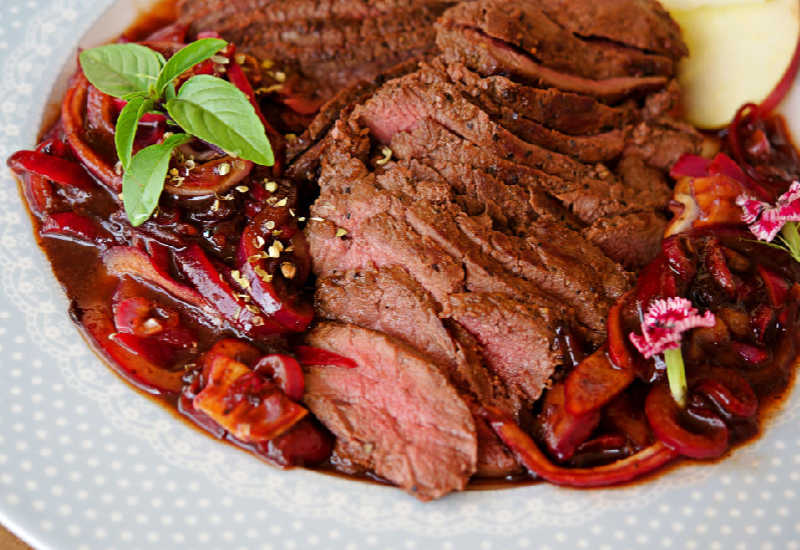
Table of Contents
What Does Kangaroo Meat Taste Like?
Kangaroo has a bold, earthy flavor with a mild hint of gaminess. It isn’t as flavorsome as venison, but is stronger than lamb or beef. The dark red flesh is very lean and is comparable to chicken or rabbit.
When cooked correctly, the meat will be tender, more so than that of deer. However, kangaroo is 98% lean which must be cooked on a high heat until rare or medium rare. A slightly over cooked steak will result in an unpleasant, dry meal that’s tough as old boots. Under cook it and it’ll be chewy.
Tip: If you only like to eat meat that is cooked well done, then beef or chicken is probably a better option.
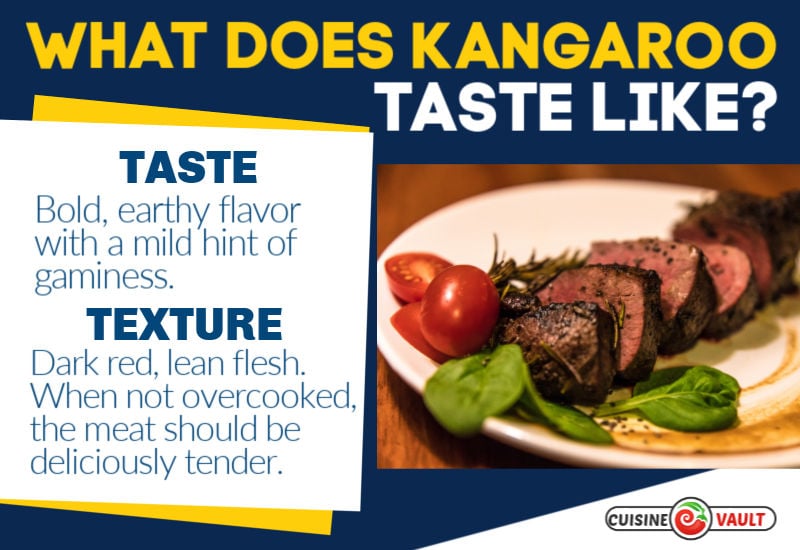
Summarizing the kangaroo’s taste:
| Flavor | Bold, earthy, gamey |
| Texture | Lean, chunky fibers |
| Color | Dark red |
| Aroma | Strong gamey smell |
What flavors go with kangaroo?
Kangaroo is a rich meat with gamey flavor that pairs well with sweet or bitter food. Choose seasoning and side dishes that balance the dish and cut through the savory, meaty flavor.
- sweet chutneys and jams
- rosemary and thyme
- garlic
- leafy greens
- beetroot
- red wine
Related reading:
What does duck taste like?
What does an octopus taste of?
What does lotus root taste like?
Recipe
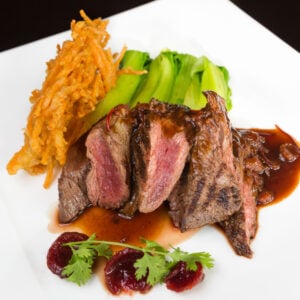
How to Cook a Kangaroo Fillet
Ingredients
- 1 pound kangaroo steak
- 1 Tbsp vegetable oil
- salt to taste
Instructions
- Sprinkle salt over both side of the steaks. Heat a skillet on medium-high heat until hot. Pour in oil and wait for 45 to 60 seconds for it to heat up. The pan should be very hot.
- Gently lay the kangaroo fillets into the pan and sear for 2 minutes, then flip them over. Continue cooking for 2 to 3 minutes until the meat has browned to your satisfaction. It must be pink in the middle or it will be tough.
- Transfer the meat to a tray and allow to rest for 5 minutes, before cutting into slices and serving.
Notes
Cooking Tips
Rest the meat: Allow the uncooked steaks to rest at room temperature for 10-15 minutes before cooking. This allows for more even cooking, rather than an overcooked outside and raw inside. Check the thickness: Heating times for kangaroo steak will vary depending on the thickness so be vigilant and don’t step away for even a minute! Adjust cook times: If you’re making sausages or mince then they should be cooked completely, rather than medium rare. Increase tenderness: Marinating the fillets in a mixture of olive oil and herbs for one hour increases the tenderness and enhances its flavor.Nutrition
Why eat 'roo meat?
Kangaroos aren’t farmed, instead they roam free in the wild which is more sustainable than other major industries such as beef farming. Roos are surprisingly drought-resistant and require less water than cattle or sheep. They breed like rabbits and are well known for decimating farmland if left alone. The culling of kangaroos in Australia is essential, so eating the meat means it isn’t wasted.
Nutrition
One of the benefits of eating a wild animal is that they are usually leaner. Kangaroos are an excellent source of protein, B vitamins, zinc, and omega 3. There is only one gram of saturated fat in a 5-ounce serving.
Kangaroo meat nutrition in a 5 oz serve:
| Calories | 137 |
| Total Fat | 2g |
| Saturated Fat | 1g |
| Protein | 30g |
| Sodium | 200mg |
The meat is also very high in iron. Check out the table below which compares iron levels in some common types of animal proteins.
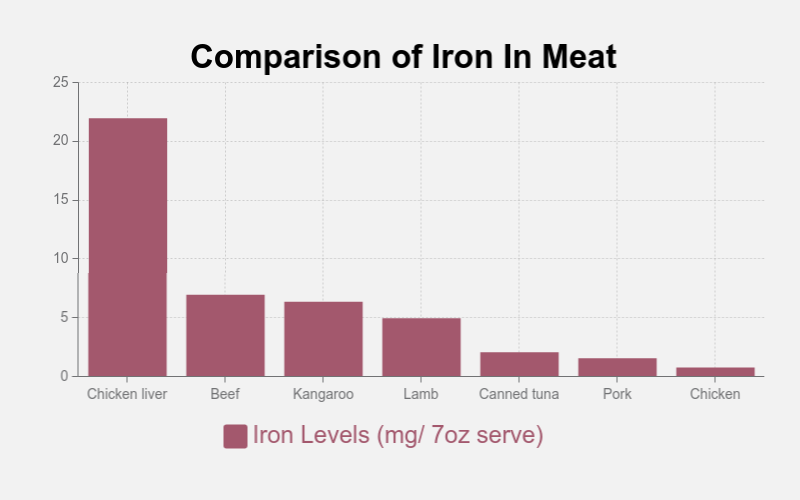
| Type of meat | Iron in a 7oz serve |
|---|---|
| Chicken Liver | 22mg |
| Beef | 7mg |
| Kangaroo | 6.4mg |
| Lamb | 5.0mg |
| Canned tuna | 2.1mg |
| Pork | 1.6mg |
| Chicken | 0.8mg |
Source: https://nutritionaustralia.org/fact-sheets/iron/
Frequently Asked Questions
Kangaroo has a stronger flavor than beef and also has a gamey feel to it. Thanks to higher fat content, beef is more forgiving and can be cooked until well done without turning overly dry. Although the two meats have similar levels of protein, kangaroo is higher in zinc, iron, omega-3, and has less fat.
Wallaby has a noticeably different taste to kangaroo. It is much less gamey with a fine texture that is best compared to veal. Wallaby is harder to find in stores, compared to kangaroo meat.
Summing Up
People that visit Australia for the first time are often shocked to hear kangaroos are on the menu. However, the meat isn’t a huge seller in supermarkets or at restaurants. Some Australians shy away from eating it on moral grounds; but a lot won’t eat it because they’ve tried it and found it tough. This is a common complaint as the meat overcooks so easily.
Is kangaroo meat worth your money? We’d recommend you try it for a new experience, but only if you’re at a good restaurant that’s likely to cook it correctly. When given the attention it deserves, you will find that 'roo meat is flavorsome and tender, with just enough gamey flavor to keep it interesting.
If you’re confident in the kitchen you could also try cooking your own. Your two best options are to slow cook it on a very low heat all day, or briefly fry it on a very high heat, ensuring the inside is pink.
If you like taste-testing different foods, check out our reviews of fugu, balut, and sea urchin. They're three challenging foods that you won't see everyday.
What is the most exotic food you’ve ever tasted? Please let us know in the comments below.
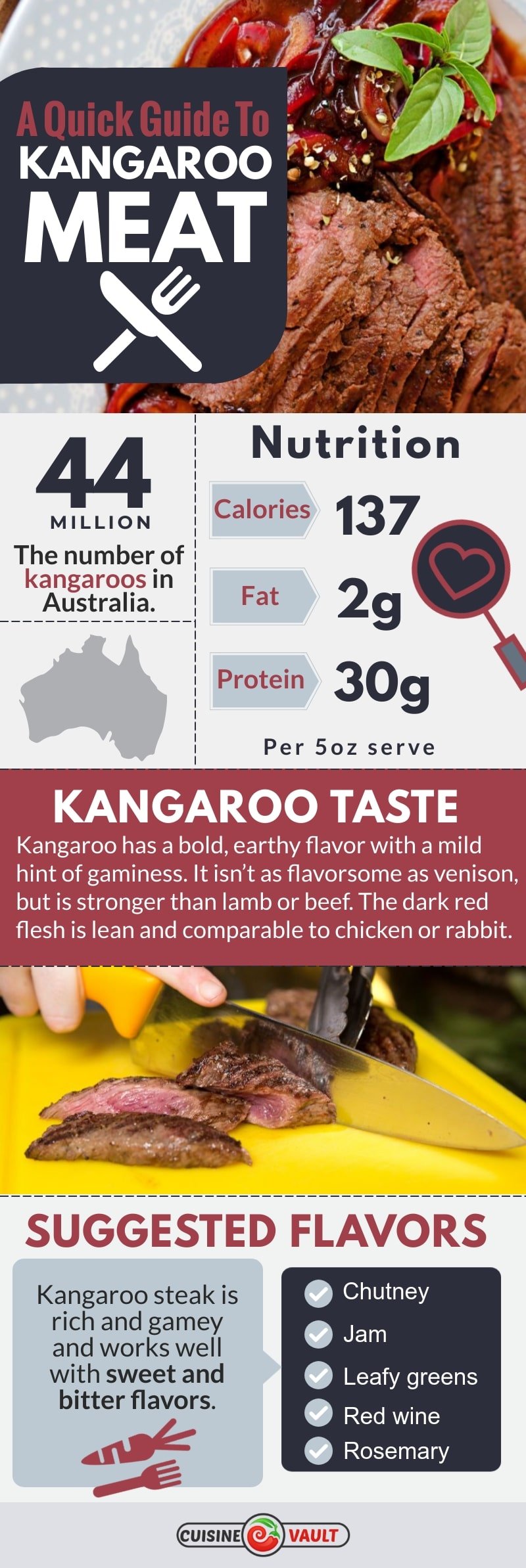

Leave a Reply